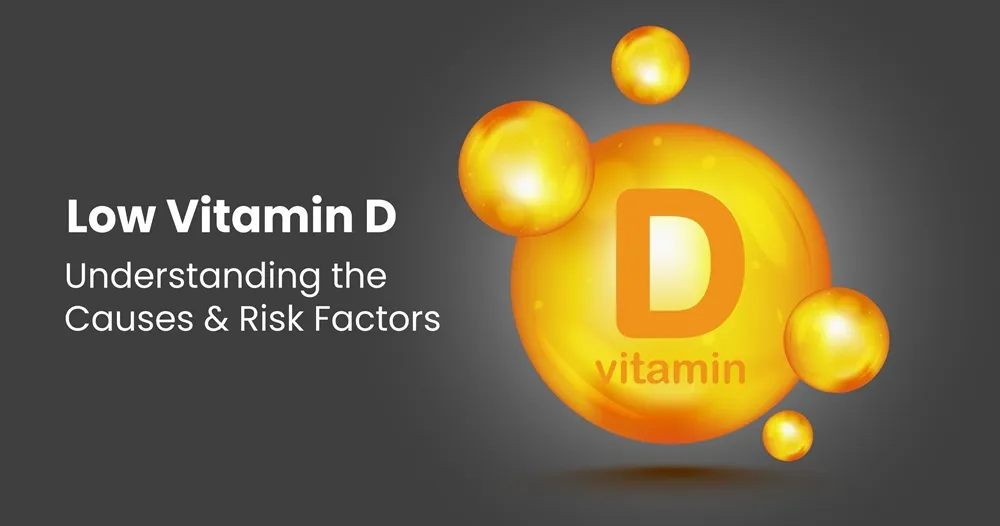Low Vitamin D: Understanding the Causes and Risk Factors
Apr 19, 2024

Vitamin D is a fat-soluble vitamin necessary for health. It strengthens bones, enhances mental well-being, and promotes better sleep. Lack of vitamin D is a widespread issue worldwide. Half of the world's population suffers from vitamin D insufficiency, and around 1 billion people are vitamin D deficient. Symptoms of vitamin D deficiency vary depending upon the severity of the deficiency and the affected individual.
Vitamin D can become deficient if you do not get sufficient amounts from the sun. At this point, you may begin to experience one or more of the symptoms of vitamin D deficiency. So, what are the signs of vitamin D deficiency to be aware of? Keep reading to find out more about the causes and risk factors of low vitamin D.
What is Vitamin D Deficiency?
When the body does not contain a sufficient amount of vitamin D to maintain muscle and bone health, the condition may be referred to as Vitamin D deficiency. Vitamin D impacts the immune, musculoskeletal, and neurological systems. Thus, a lack of vitamin D can lead to associated conditions in these systems. There are several ways to get vitamin D, such as:
- Through sun exposure on your skin (although older adults and those with darker skin tones might not receive enough vitamin D from sunshine. Inadequate exposure to sunlight for vitamin D may also be hindered by your geographic location).
- Through the food you consume.
- Using dietary supplements.
However, Vitamin D deficiency is still widespread worldwide despite the availability of multiple ways to obtain the vitamin.
Signs And Symptoms of Low Vitamin D
Low vitamin D in the body can be difficult to diagnose because it either produces no symptoms or has symptoms that overlap with other health conditions. Symptoms and signs of low vitamin D levels could be:
- Fatigue and Tiredness
- Frequent Illness
- Muscle Pain and Weakness
- Back Pain
- Bone Fractures and Osteoporosis
- Hair Loss
- Depression
- Weight Gain
- Eczema
A severe vitamin D deficiency in children brings on Rickets. The associated symptoms include:
- Abnormal growth patterns due to bent or bowed bones.
- Muscle weakness.
- Bone pain.
- Deformities in joints.
Children with mild vitamin D deficiencies may only experience muscle pain, soreness, and/or weakness.
What are the Causes?
In general, there are two primary causes of vitamin D deficiency:
- Inadequate exposure to sunlight or dietary sources of vitamin D.
- Vitamin D is not being properly absorbed or used by your body.
A vitamin D deficiency can be caused by several specific factors, such as:
- Certain medical conditions.
- Weight loss-surgeries.
- Certain medications.
Age and the amount of melanin (pigment) in your skin are two more biological and environmental factors respectively, that can increase the risk of developing vitamin D deficiency.
What are the Risk Factors?
The lack of vitamin D has multiple risk factors. However, a few lifestyle choices or underlying medical issues could raise the overall risk. For example,
- Having darker skin
- Mothers breastfeeding their babies
- Adults 65 years of age and older who are overweight or obese, who live in places with little light year-round or far from the equator, or who receive little sunlight
- Having a persistent liver or kidney condition
- Having a medical condition like Crohn's disease or celiac disease that interferes with the body's ability to absorb nutrients
- Using drugs like statins
 that interfere with the metabolism of vitamin D
that interfere with the metabolism of vitamin D
When to See a Doctor?
Vitamin D deficiency can have mild symptoms, which mostly makes diagnosis challenging. Moreover, it can exist without presenting any symptoms.
If you encounter any symptoms, seek medical attention for low vitamin D levels. To determine your levels, the doctor will perform a blood test for 25-hydroxy vitamin D. In addition, they could rule out alternative explanations for some of your symptoms.
How to Increase Your Vitamin D Intake?
The best way to avoid vitamin D deficiency is to get adequate vitamin D from your diet and/or sun exposure. However, avoid spending too much time in the sun without using sunscreen. Excessive sun exposure increases the risk of skin cancer.
Your age determines how much vitamin D you require daily. The recommended daily average doses are shown below in International Units (IU) and micrograms (mcg).
|
Age / Life Stage |
Recommended Doses |
|
Infants up to 12 months old |
10 mcg (400 IU) |
|
People 1 to 70 years old |
15 mcg (600 IU) |
|
Adults 71 years and older |
20 mcg (800 IU) |
|
Pregnant and breastfeeding people |
15 mcg (600 IU) |
You can also consume some food items that naturally contain vitamin D, such as:
- Fatty fish like tuna, salmon, mackerel and sardines
- Rainbow trout
- Beef (cow) liver
- Mushrooms
- Egg yolks
- Cod liver oil
Fortified foods also contain vitamin D. To determine whether a food contains vitamin D, make sure to read the nutrition labels. Foods that frequently contain additional vitamin D include:
- Almond, soy, oat, and cow's milk
- Breakfast cereals
- Orange juice
- Other dairy products, such as yoghurt
Similarly, many multivitamins contain vitamin D, and vitamin D supplements are also available. If you're concerned about getting enough vitamin D, consult your doctor.
Final Words,
Low vitamin D levels in the body are surprisingly common, but the symptoms are often subtle and nonspecific, making it difficult to determine whether you have a deficiency or another health condition. If you believe you might be deficient, get a blood test from a medical professional. Supplements, dietary modifications, and lifestyle adjustments are typically used to treat vitamin D deficiency.
Apollo Diagnostics can help you identify vitamin D deficiency. We offer various body test packages in the comfort of your home with precise results as we follow safe and secure testing procedures. To find out more about what your body requires, schedule your test right now.
FAQs
- When should I see a doctor for a vitamin D deficiency?
Speak with your healthcare provider if you have questions about whether your body uses vitamin D properly or if you're not getting enough of it.
Your healthcare provider might advise routinely monitoring your vitamin D levels to make sure they are within a healthy range if you have any risk factors for vitamin D deficiency.
- Can a vitamin D excess be harmful?
Vitamin D toxicity, or getting too much of it, can be harmful.
- Toxicological symptoms include loss of appetite, nausea, vomiting, constipation, weakness, and weight loss.
- High doses of vitamin D can even cause renal damage.
- It also increases the blood's calcium content.
- Hypercalcemia, or high blood calcium levels, can lead to arrhythmia, confusion, and kidney failure.
- What issues are a vitamin D deficiency related to?
A lack of vitamin D can cause a reduction in bone mass, which may lead to osteoporosis and fractures (broken bones). Moreover, severe vitamin D deficiency can cause the following illnesses:
- It can result in rickets in kids.
- Osteomalacia is the result of severe vitamin D deficiency in adults.
- Muscle weakness, bone pain, and weak bones are all symptoms of osteomalacia.
- What are the recommended Vitamin D levels for optimal health?
Optimal levels of Vitamin D are generally considered to be between 20 ng/mL and 50 ng/mL. However, recommendations can vary based on age, health conditions, and other factors.
Related Blog Post
Blog Categories
- Child Health
- Mens Health
- Women's Health
- Mental Health
- Health Myths & Facts
- Fitness
- Nutrition/Recipes
- Remedies
- Weight Management
- Stress Management
- Health Supplements
- Addiction Management
- Disease Management
- Allergy
- Anemia
- Arthritis
- Asthma
- Autoimmune Diseases
- Blood Pressure
- Cancer
- Deficiencies
- Dengue/Malaria/Chikungunya
- Diabetes
- Eye Problems
- Heart Diseases
- Hepatitis
- HIV/AIDS/STD
- Hormonal Imbalance
- Infection/Flu/Viral
- Kidney
- Liver
- Menstrual Problems
- Pregnancy
- Skin & Hair Problems
- Stomach Ailments
- Thyroid
- Others
- Health Checkups
- Diagnostics/Pathology
- Lifestyle & Wellness
- Covid
- Medical Tests
- Cholesterol
- Health Tips
- Parent Care/Old Age
- Lungs
- Food Intolerance








